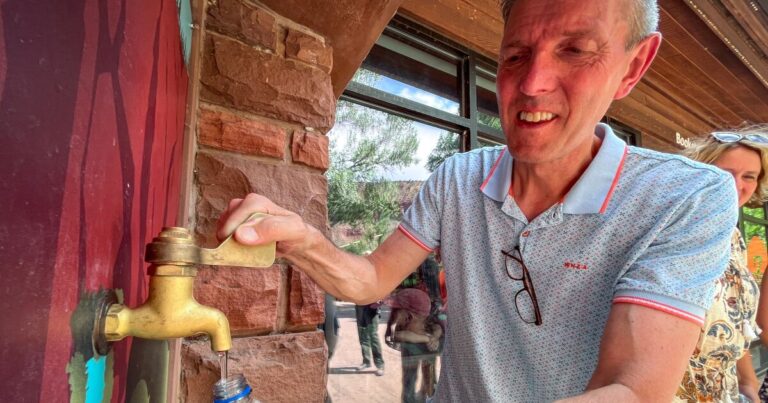It’s no secret that St. George’s population growth is on the verge of colliding with its limited water supply. But what about the tourists and snowbirds who flock there?
On a typical peak day, such as Labor Day weekend, visitors and seasonal residents account for more than a quarter of Washington County’s population, according to 2019 estimates from the Kem C. Gardner Policy Institute. occupied.
This would add an additional 57,069 people not included in the county’s already explosively growing population (more than 200,000 people). This means the county’s burden to provide water far exceeds what a typical community of its size would face.
“I have no control over growth. I don’t promote it. I don’t prevent it. I simply react to it. And our job is to be prepared,” Washington County said. said Zach Renstrom, water conservation district manager.
He said there’s only so much the district can do to get its water conservation message across to people who are only in the district temporarily, but at least taking temporary water users into account can help inform long-term planning on how much more wastewater recycling and other efforts need to be strengthened.
“Sometimes we ask them to change, and sometimes we recognize that we need to change.”
The analysis split the total of 57,069 people roughly evenly between 28,103 tourists and 28,966 seasonal residents. The district believes this is a conservative estimate and has likely increased even further since the report was released five years ago.
The ward expects that number to continue to increase as the resident population increases. Based on Kem C. Gardner’s projections, the total number of permanent residents and temporary residents could reach nearly 700,000 by 2060.

Washington County Water Conservation District
This graph shows how the number of tourists and seasonal residents (shaded in orange) is expected to grow along with Washington County’s permanent population in the coming decades.
The question now is how much the county can involve tourists and vacation home owners in the conservation plans it’s pushing for full-time residents.
In 2023, the district began imposing additional fees on high-volume water users. If a customer uses more than 36,000 gallons per month, there will be an additional charge of $10 per 1,000 gallons. Cities in the county have also implemented their own tiered water pricing systems.
It is unclear how effective these fees will be when charged to vacation homes. Restrom said a district analysis found that seasonal residents use only 10 percent less total water per year than full-time residents, even if they are only home half the year. .
This shows how much lawn irrigation can impact water use, Renstrom said.
“They’re going to show up for the weekend…and they want that landscape to look perfect. They want the grass to be perfectly green….So what happened is… Landscapers don’t want to call and end up using too much water on the landscape.”
He said that because tax records show that about 20 percent of the homes in the county are not the owner’s primary residence, all the extra water usage adds up. These additional users also skew the county’s per capita water use rate, which has drawn attention in recent years for being higher than other Southwest cities such as Las Vegas and Tucson.
“We have been beaten down many times. [that]. But when you think about it…he has 50,000 people who aren’t counted there. [population] That really throws everything off,” Renstrom said.
The Greater Zion Convention and Tourism Office estimates that between 8 million and 10 million people visit Washington County each year, which is more per capita than Clark County, Nevada, home of Las Vegas.
In 2023, Zion National Park attracted more than 4.6 million visitors, the third most on record and the third most of any national park in that year. Sand Hollow State Park near St. George will be the state’s most visited park, attracting more than 1.4 million visitors by 2023.
So when it comes to reducing tourism’s water impact, it’s important to get the message across in as many ways as possible, said Kelly Bricker, vice president of the Global Sustainable Tourism Council.
“It is a large part of our responsibility as hosts to ensure that our guests are educated and knowledgeable about considerations specific to their particular environment.”
Mr. Bricker is the Director of the Joint College of International Tourism at Hainan University and Arizona State University and Professor Emeritus of Parks, Recreation and Tourism at the University of Utah.
Another thing that helps is spreading out your visitors instead of having them all come during peak hours. Marketing that emphasizes the benefits of visiting during the off-season could encourage that, she said, as well as timed entry systems like permit requirements at Angel’s Landing in Zion National Park.
However, at some point, the never-ending growth of tourism does not necessarily benefit residents who have to deal with the effects of the water scarcity crisis. Washington County’s recent population growth has already taken advantage of its primary water source, the Virgin River.
“We don’t want to jump in and close the door behind us. But I think we have to start thinking more carefully about what our natural environment can withstand.”
Many rural communities with outdoor recreational attractions have sounded the alarm about this during the pandemic, seeing how rapid growth in tourism is straining infrastructure and natural resources, she said. said.
But she said it can be a difficult balance to strike when tourism drives the economy — bringing in more than $1 billion to Washington County in 2022.
“We need to consider what the limits are, especially in areas where basic requirements for survival, such as water, are lacking. [tourism] Growth and how to manage it? This is a difficult question for people to deal with, especially when they directly benefit from the tourism economy. ”

